CHAPTER VI
BETWEEN WARS
Guantanamo Bay had a period of relative quiet after World War I. It took a few years to recover from the effects of demobilization and to get the ships manned and under training again. A large portion of the U. S. Fleet was shifted to the Pacific. The Atlantic Fleet, reduced considerably in size, resumed use of Guantanamo for its winter maneuvers, and in years to come, there was to be an occasional fleet concentration of both Atlantic and Pacific Fleets in the Caribbean.
Due to post-war apathy and the Limitation of Armaments Conference in Washington in 1922, any further development of the Naval Station was suspended. Ships visiting the area depended largely on supplies brought along. Ships called on the Naval Station only for their of fuel, fresh water, and fresh provisions, and for the services of the rifle ranges.
From September 1920 to June 1921, Commander John J. Hannigan, USN, then known among the other officers as the "bear-cat," was Commandant for a short period, succeeding Commander Whitlock. An officer at one time after visiting Commander Hannigan on official matters asked the chief clerk why he did not provide a set of boxing gloves so that the Commandant could use them with each caller, as it seemed to him that the Commandant was always ready for a fight. It can be assumed that in any encounters that developed he was usually victorious.
Commander Robert T. Menner relieved Commander Hannigan as Commandant and served until May 1923. The only item of this period deserving special mention was the construction of Pier "A"; it was started in 1921 and completed in l922.
Fleet Concentration
The next Commandant was Captain Ward K. Wortman, whose tour of duty was rather short, from May 1923 to June 1924. it was during his time that the first post-war fleet concentration took place, bringing together in this area the Pacific and Atlantic Fleets. This concentration was in the winter of 1924.
By this time the pattern of winter fleet exercises had been set, with the Atlantic Fleet basing at Guantanamo for winter training, usually from early in January until late April. The Pacific Fleet was to join them in the Caribbean approximately every three years. Each winter the station took on added life and did its best to serve the Fleet with its limited facilities. Caimanera, Boqueron, and Guantanamo City enjoyed a definite economic shot in the arm, particularly Caimanera. This being the prohibition era, the station was dry. Nearby Caimanera provided a temporary oasis to the visiting officers and men of the Fleet, as it did to station residents the year around.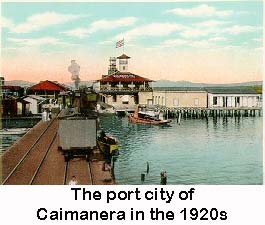 Caimanera provided rum, cigars, gambling, and various forms of entertainment, some not too wholesome. Limited hours of liberty and an efficient shore patrol, however, kept personnel out of real trouble. It was probably there that our "good neighbor" policy had its start long before it was publicly proclaimed. Nearby Cuban cities provided amusement and a friendly welcome, and we provided good will and enough dollars to bolster the local economy. Many wealthy Cubans of today got their start from those days.
Caimanera provided rum, cigars, gambling, and various forms of entertainment, some not too wholesome. Limited hours of liberty and an efficient shore patrol, however, kept personnel out of real trouble. It was probably there that our "good neighbor" policy had its start long before it was publicly proclaimed. Nearby Cuban cities provided amusement and a friendly welcome, and we provided good will and enough dollars to bolster the local economy. Many wealthy Cubans of today got their start from those days.
Not All Play
Lest it be inferred that recreation ashore was the primary concern of Fleet personnel, it should be emphasized that the Fleet when based at Guantanamo made the most of the excellent opportunities for training. It spent a considerable time at sea, drilled, maneuvered, and fired battle practices. Naval Aviation had a landing field at Hicacal Beach and did considerable flying. In general the Fleet worked hard. On leaving each year for northern ports, the Fleet was always a well-trained fighting force.
Captain Charles M. Tozer relieved Captain Wortman and was in command from June 1924 to June 1926. Captain Tozer came from Destroyer Squadron Nine of the Scouting Force, and had earned a reputation in naval gunnery.
During the year 1926 a writer the name of K. C. McIntosh, spent seven months at Guantanamo Bay, this not being his first visit since he had also been here in 1906. He wrote an article on Guantanamo which appeared in the American Mercury (January 1927 issue). His word picture of Guantanamo Bay in 1926 is considered worth quoting. Excerpts from the article follow:
"About eighty miles westward, after rounding the winking light of Cape Maysi, there is another lighthouse on a low flat promontory jutting out from the scrubby hillside, where McCalla Hill enters the sea.."
Life At Guantanamo
"On the steep shores of a ragged inlet, cut through the mangroves, is the naval station. Here are the target range and recreation field, the oil tanks, power plant and storehouses. Along the cliff-top the low green bungalows of the quarters nestle in a tangle of palm and trumpet vines, a flowery oasis in a desert of scrub and thorn. Here and there a bluejacket will be clattering a typewriter by an open window or languidly overhauling a motorboat engine. The crew of the oil barge are scrubbing clothes on the deck, one of them whistling thinly through the still heat. Here and there, a handful of officers, bleached white as their uniforms under the wide pith helmets, plod doggedly along at their duties. If the day is not too hot, their wives are riding lazy ponies over the hill to call on the ladies of the Marine Corps. Chinese coolies methodically tend to the boilers of the power plant or push tiny flat cars under the somnolent direction of a brown Cuban foreman."
"Once a month the Kittery comes in with passengers and freight for Haiti, Santo Domingo or the Virgin Islands, and the Station gives a tired dance at Caimanera. Four times a week the mail comes overland from Havana. Fresh water costs twenty-five cents a hundred gallons. Old Civil Service clerks thankfully close their desks as the shadows start to lengthen, and scramble into motorboats to go home and loll on their breezy porches on the bare crest of Hospital Key. A shout or a loud, hearty laugh would be as noteworthy in Guantanamo as it would be in a church. There is just enough tennis to keep in condition, just enough swimming to keep moderately cool, just enough bridge of an evening to exhaust the conversation of your neighbors, and an occasional ride up the bay for a cocktail on Pablo's back gallery or a cold bottle of beer in Jim Beauzay's or O'Briens. Even babies seldom break the drowsy routine, for expectant mothers usually hurry back home to the states."
"Things picked up when the Fleet came steaming in. Aircraft tenders and rows of scout and torpedo planes over by Hicacal (called High Cackle). All gunnery and more gunnery."
Immensity of Bay
"�Fish Point, where the Marines live, and the Cable station, which hides behind papaya trees; the great stretch of the target range and the immense recreation field where ten baseball games way be going on so far apart that one can scarcely hear another's cheering. Hicacal Beach, where the airplanes tune up and the Commandant plays golf; Toro Key, Hospital Key, Smallpox Point-all these I know. I have been miles up the Freshwater river hunting non-existent crocodiles. I know the hot, spiny brush of the Eastern hills, where tradition says deer-hunting used to be worthwhile. I know the three towns of the upper bay and can put my finger on the exact spot on the chart where the scurryinq, coughing motor boats leave United States territory and become foreign visitors in Cuba . . . Yet I don't know how big the bay is�"
"Baseball teams spill over the recreation field, and on Hicacal Beach are hundreds of swimmers. By avoiding the eighth hole altogether and shooting from the ninth tee to the seventh green, officers may get a round of exasperating golf. Spring tides roll inches deep over the fairways, and the bare greens are full of crab holes, but you can't expect everything."
"From McCalla Hill, where the old Spanish gun crouches, I have seen a tiny huddle of ships in a great expanse of water, and that huddle was the whole fighting sea power of America . . ."
"Only by crossing in a speedboat can Guantanamo's immense magnitude be appreciated. As the squat bungalows and oil tanks of the Navil Station fade from sight against the dull green hillsides, the tiny standpipe on Hospital Key grows into a huge towering water tank perched on a yellow bluff overhanging the coal pockets. Then the key dwindles in the wake, and the red smudge to the left and the white blur to the right expand rapidly into the railroad terminals of Red Barn and Boqueron, with ocean-going steamers loading at the long wharves or anchored in the stream offshore. By that time the upper end of the bay has moved on to the long ramshackle waterfront. At Caimanera the bay again sweeps on the rolling soft green of the sugar country, which lies between rusty mountain slopes."
Liberty in Caimanera
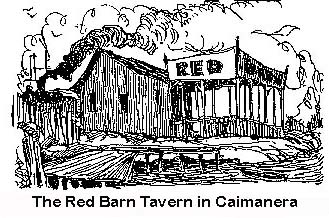
"On liberty, junior officers stopped at the Red Barn because you could "get there ten minutes earlier". Pablo, Pepe, Jim and Chico had places in Caimanera. "Peanut Mary" was also a fixture."
"A rickety wooden building like a squat barn built on piles over whispering, greenish water; a long battered mahogany bar; a hundred white and gold uniforms at white topped tables that are littered with the remnants of salad and fried chicken, and are sloppy with beerfroth and the chill sweat of highball glasses. A hundred grinning black faces at the wide glassless windows on the street side. Lean, nondescript dogs snuffing for scraps on the floor and cringing when looked at. Target practice was over, the maneuvers were finished, and the Scouting Fleet was sailing for home in the morning; and everyone not on watch was ending the winter's work with a whoop in the queer little village of Caimanera."
Captain Charles C. Soule, Jr., relieved Captain Tozer and was Commandant from June 1926 to August 1928. He had been Captain of the Naval Academy football team in his time and an "All American." He was also a sailing enthusiast. He organized the Spartan Yacht Club consisting of 14 yachts. So well was this club handled that when matched against the crack sailboats of the Fleet when present in the area, the Spartans invariably carried away the honors. It will be recalled that in those days ships in the Fleet carried boats capable of being rigged for sailing. Captain Soule undertook to write a history a history of the station, but it apparently never was accomplished. Some of the letters from former Commandants responding to his inquiries are on file.
Several improvements to the Naval Station were accomplished during his administration, among them the erection of a distilling plant and rebuilding the fuel pier.
Worst Drought
The years 1925-27 saw the most terrible drought ever to be experienced in this area. All the rain the station had for two years consisted of two light showers. The consequences were keenly felt.
In the winter of 1927 the Atlantic and Pacific Fleets held joint maneuvers and concentrated, 210 ships strong, in the Guantanamo area. In 1951 Captain R. E. Bassler, (CEC), USN, who was Station Public Works Officer (1925-27), sent to the writer an interesting old photograph. This photograph showed the baseball championship game being played that year (1927) on the fleet athletic field located on the rifle range. The picture, together with several other contemporary scenes of the station which Captain Bassler sent, hangs in the Base Commander's office.
It was during Captain Soule's administration that a big hurricane passed about 50 miles to the southward of Guantanamo Bay, close enough to hit the station with considerable fury. Mr. Paul L. Barrett, who was here at the the time as the Commandant's Chief Clerk, dramatically describes the event in these vivid words:
Big Hurricane
"It was the 7th day of August 1928. The sun all that day was arrayed in all its splendor and glory hanging in a cloudless sky, and stood with great majesty on the horizon towards the close of the day. The twilight in its crimson gave the reflection of nature's bountiful beauty; with the stars later flickering in the celestial dome; no thought was given to any impending danger, although the barometer registered very low. About 2000 that night Nature suddenly threw off her beautiful and innocent garb in exchange for one of terror and began to put on a diabolical form. Things changed in a hurry, then the stars hurried to hide themselves from the wrath to come. An impenetrable darkness brought on sudden winds varying in intensity until it arose to a velocity of 80 miles per hour. Everything happened as if a demoniac fairy had passed her evil wand in the air-a hurricane was on. It was fifty miles off the path of center and it wrought havoc in its wake. Heavenly rain followed amid the horrified screams of women and children, the hissing of the wind, the walloping of the waves, the howling of dogs, the uprooting of trees, the blowing of roofs from buildings, the falling of telephone poles-all this gave rise to panic.
"The power plant and the radio station became numb and we were cut off from communication with the rest of the world. Fortunately no lives were lost. Oldtimers in a near-by town declared it to be the most severe hurricane that had been witnessed in the lapse of half a century. The storm lasted for all that and the following day. On the morning of the 9th the sun rose with resplendency looking calmly down upon all of the destruction with an innocent glee. Captain Soule was detached the following day."
The narrator of this account makes plain that his juxtaposition of the last sentence with the rest had not the slightest innuendo that Captain Soule was in any way held responsible for the catastrophe nor that his detachment was ordered
because of it.
Commander Charles S. McWhorter, who relieved Captain Soule, was noted as a baseball player and had been captain of the Naval Academy baseball team. He was Commandant from August 1928 to June 1930. During his time, in 1929, the ordnance pier (Pier "D") was rebuilt.
"Guantanamo Blues"
In 1930 a short story appeared in Liberty magazine (12 April 1930 issue) entitled "Guantanamo Blues"-by "A Navy Wife." It was banned from the station for a number of years. After reading the story the reasons for the author desiring anonymity are obvious. It is a distorted picture of life at Guantanamo with the Fleet present, emphasizing drinking and sex, done with neither subtlety nor skill. The author seems to feel that Prohibition was in part responsible. Prohibition being a thing of the past and not a current issue, the story should be allowed to die along with the "Noble Experiment," and not be dignified further by comment or criticism.
Commander McWhorter was detached in June 1930, and Commander Alfred H. Miles took command two months later in August. His tour of duty was a short one, about seven months. Commander Miles was the author of the words to "Anchors Aweigh." His wife was the great-great granddaughter of President Tyler, and her father was president of William and Mary College during her residence here.
One of the notable events of Commander Miles' regime was the building of a dirigible mooring mast on McCalla Hill and the and the reception of the first dirigible, the Los Angeles.
Marquez Ranch
The year 1930 saw an upheaval in the field of supply, particularly with respect to the procurement of beef and milk, which were critical items in the life of this isolated colony. This upheaval caused internal dissension on the station. In order to understand what happened, it is well to go back and briefly review the situation as it developed over the years.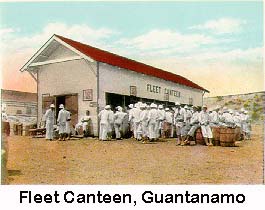 In the early days of the station, perhaps as far back as 1910, a Cuban by the name of Massip had been authorized to live on the premises (he lived on Massip Hill, now Chapel Hill), and to run a canteen for Fleet personnel. He also is reputed to have rented horses and sold beef and fresh milk to station personnel. In 1920 another Cuban, Abelardo Marquez, was given a grazing concession on station lands on the eastern part of the reservation, which resulted in the so-called "Marquez Ranch" (later known as "Randolph Ranch") and some slaughtering facilities, which were the property of Sr. Marquez but located on the station. From these came beef, veal, and milk, which Marquez provided under contract. He also was allowed to conduct a canteen on the target range. Sr. Marquez took up residence on the station in the house formerly occupied by Massip.
In the early days of the station, perhaps as far back as 1910, a Cuban by the name of Massip had been authorized to live on the premises (he lived on Massip Hill, now Chapel Hill), and to run a canteen for Fleet personnel. He also is reputed to have rented horses and sold beef and fresh milk to station personnel. In 1920 another Cuban, Abelardo Marquez, was given a grazing concession on station lands on the eastern part of the reservation, which resulted in the so-called "Marquez Ranch" (later known as "Randolph Ranch") and some slaughtering facilities, which were the property of Sr. Marquez but located on the station. From these came beef, veal, and milk, which Marquez provided under contract. He also was allowed to conduct a canteen on the target range. Sr. Marquez took up residence on the station in the house formerly occupied by Massip.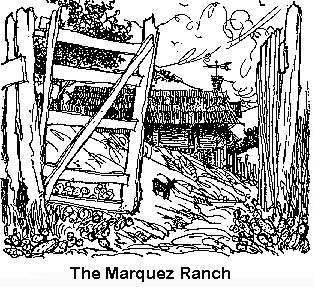 In 1926 the Commandant was the recipient of a letter censuring the concession to Marquez as a violation of the US-Cuban lease agreement of 1903 which forbids private enterprise. This was the first of many such complaints, most of which emanated from disgruntled Cubans. Thus the problem took on an international aspect. In an effort to clarify the questionable operation and to comply with lease terms, nominal control of the ranch and facilities was vested in the Ship's Service Department. Thus the matter rested for a few years.
In 1926 the Commandant was the recipient of a letter censuring the concession to Marquez as a violation of the US-Cuban lease agreement of 1903 which forbids private enterprise. This was the first of many such complaints, most of which emanated from disgruntled Cubans. Thus the problem took on an international aspect. In an effort to clarify the questionable operation and to comply with lease terms, nominal control of the ranch and facilities was vested in the Ship's Service Department. Thus the matter rested for a few years.
In 1930 at the request of the Commandant an inspection was made by Captain Charles Conard, (SC), USN, in which he questioned the propriety of permitting the beef contractor (Marquez) to reside on the Station and conduct his business there, in view of treaty-lease prohibition of commercial establishments on the station. Captain Conard recommended that consideration be made of other local sources, off the reservation. Accordingly, Marquez was directed to move off the station, but not without protest from his friends; and other prospective suppliers were brought into the picture. Notwithstanding this turn of events, contractual arrangements with Marquez for the supply of beef continued in effect, and late in 1930 the government entered into a lease with Marquez and agreed to pay $400 a year for the use of his ranch and slaughtering facilities, stipulating however that if Marquez did not obtain the contract for beef, he must remove his facilities from the station, and the lease would be cancelled.
Competitive bids for the supply of beef were opened and the Marquez bid was accepted. There was considerable dissatisfaction among other competitors and the matter was aired locally and in the Navy Department, with subsequent informal investigations of the situation. The records of the time are incomplete and rather confusing, but it appears that the affair was disrupting and split the station into two warring factions. No attempt will be made to evaluate the merits of either side. As it turned out, Marquez, while off the station personally, held the beef contract for several years thereafter. Eventually the situation was remedied by the Navy setting up its own facilities. (How much simpler it is at the present time when all enterprise on the Base is government-run and practically all supplies are brought in by government carriers).
"Destroying Angel"
Commander Miles was detached in February 1831, and was relieved by Captain Thomas L. Johnson. Captain Johnson is reputed to have been a reformer and to have prosecuted a reform program with vigor. It seems that over a period of years a number of aliens allowed to build personal houses and shacks on the premises, with lumber and materials which had been procured from scrap piles or in unorthodox ways. There was no formal authority for such buildings and they did not appear on station blueprints. Captain Johnson ordered all unauthorized buildings to be torn down. As a result he acquired the name among civilias as the "destroying angel," and was thought to be excessively severe. He was seldom known to smile. Apparently, Captain Johnson considered that administration in the past had been loose and he conducted a crusade against loose practices, grafters, squatters-perhaps at the expense of his popularity. He is credited with having "straightened things out." The Navy Department apparently approved of his administration with its stern measures for he remained in command for over two years, from February l931 to May 1933.
In June 1933 Commander Edward C. Raguet took command. He served one year until June 1934. Commander Raguet was a communications expert, having served several tours of duty in naval communications. During his tour he was able to procure modest funds for station improvements to the marine railway, school, Fleet buildings, and recreational facilities. A golf course was started near McCalla Hill.
Fall of Machado
August 1933 saw the fall of the "Machado" regime in Cuba. It became difficult to dispatch and receive mail at Guantanamo Bay and the cable station once again served a most useful purpose. During this era, financiers, owners of sugar mills, business men, and high ranking Cuban officials found a haven on the station. All those who were shrewd or fortunate enough to reach the station in time escaped possible assassination and murder. U. S. Naval vessels cruised around the coast of Cuba ready to act for the preservation of lives and property. Americans in the interior of the country were not molested, but Cuban compatriots were shot down like flies by the revolting party. These were tragic times for Cuba, but the station, aside from isolation, was not greatly affected.
In the winter of 1934 there was a U. S. Fleet concentration in the Caribbean, basing at Guantanamo. The assembled ships numbered 157. The Fleet later visited New York.
Commander Charles M. Cooke, Jr., (now an Admiral, USN on the retired list and considered an expert on China), was Commandant from June 1934 to April 1936, in a period of relative calm. Commander Cooke, usually known as "Savvy" Cook among his contemporaries, graduated number two in his class. During his term a recreation house was built on John Paul Jones Hill, overlooking the Caribbean. This house was known as "Mountain House," and was used primarily for the recreation and pleasure of Officers Club members and their families. Small parties could remain overnight and enjoy the cool breezes and the experience of "camping out." A few years later on, the writer was a guest at "Mountain House" and had the novel (for him) experience of driving a Ford sedan down the steep hillside at night.
At this time, or later, there was also a "Beach House" at Windmill Beach primarily for the use of enlisted personnel and their families.
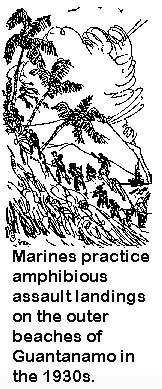
During Commander Cooke's time a serious study of the water supply situation was made. He recommended the Yateras River project, which was later adopted. Also early but small amphibious operations were conducted on one of the outer beaches, using the station ship, Woodcock, and local Marines. Lt. Colonel Clapp, the Marine Barracks Commanding 0fficer, collaborated with Commander Cooke in the initial development on a small scale of amphibious techniques later to be tried in war.
Captain Mark L. Hersey, Jr., was Commandant from May 1936 to June 1938. He is now a Commodore on the retired list and has recently written of his tour at Guantanamo. The following excerpts are worth quoting:
"Our biggest service job was with a PBY squadron from Coco Solo ... I think there were 12 planes and a tender, and they were with us for a month or more for high level bombing, as they could never get the proper ceiling in the Panama area�"
Coaling Station Expires
"One activity which expired in my time was the coaling station on Hospital Key, which I believe was our original excuse for taking over Guantanamo Bay. At that time we had two survey ships, the Hannibal and a converted yacht (the name of which I have been trying to recall), and they were our only customers for coal. I had long since recommended that we write off the few remaining hundreds of tons of coal, left over from the Spanish-American War or earlier, but we had to service these two ships. The end came when we gave the ex-yacht, Mackey Lewis commanding, a final shot of what was left. He got up to the north coast of Cuba and found that the stuff would not burn. He nearly rammed Cuba before a tig picked him up and towed him to the U.S. Then the Department believed me and closed the coaling station."
In 1938 the station allowance of military personnel was 22 officers and 282 men. Of the officers 17 were naval officers and 5 were Marine. The enlisted allowance was 153 navy and 129 Marine.
Captain Worrall R. Carter followed Captain Hersey from June 1938 to August 1940. During his tour of duty the war clouds began to gather over Europe, and the Navy Department was confronted with the responsibility of surveying its outposts and determining the adequacy of its defense bases. Late in 1938 the Naval Station was visited by the Hepburn Board and recommendations were made for the expansion of the station to include substantial air facilities so important in modern warfare. One step toward expansion was already taken. A water supply system was being built, and on 1 July 1939, the station started receiving water from a pumping station on the Yateras River.
The Great Expansion
Captain Carter was detached shortly after President Roosevelt declared an unlimited emergency, and millions of dollars were appropriated for a naval operating base. This program will be discussed in later chapters. Prior to the execution of this program, starting in 1940, the station consisted of the following buildings and structures, 279 in all, in the following categories:
Family Quarters-25 officers, 13 enlisted, 13 civilian
Personnel Buildings-2 BOQs, 23 enlisted barracks, 19 civilian barracks
Shops-5
Power Plant-1
Administration buildings-9
Storehouses-10
Magazines-4
Tanks-9 oil, 14 water, 3 gasoline, 1 fire protection
Others-128
Runways for airplanes-
McCalla Hil, 1 N-S graded earth runway
Leeward Point, 1 E-W graded earth runway
Hangar-1 seaplane hangar (under construction)
Two concrete parking areas for seaplanes.
In this and the preceding chapters the historic high-lights of Guantanamo Bay and the Naval Station have been covered from the earliest times up until 1940.
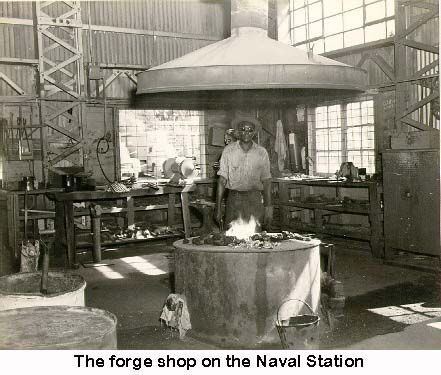
Chronologically, the next step would be to go into the World War II era. However, there are many subjects that have been given only light treatment. There are the matters of naval aviation, and such other subjects as the activities of the Marines subsequent to 1898, the story of our water supply problem, and why we have a cable station on the Naval Reservation. Then, too, various departments of the Naval Station deserve to be discussed separately, among them being Supply, Ship's Repair, Ordnance, Communications, Medical and Public Works. It is therefore fitting to pause in the chronology and in the next few chapters cover the foregoing subjects in some detail, even though it will entail some repetition. After these few chapters, the history of the epochal 1940 decade will be undertaken.
Go to Chapter Seven